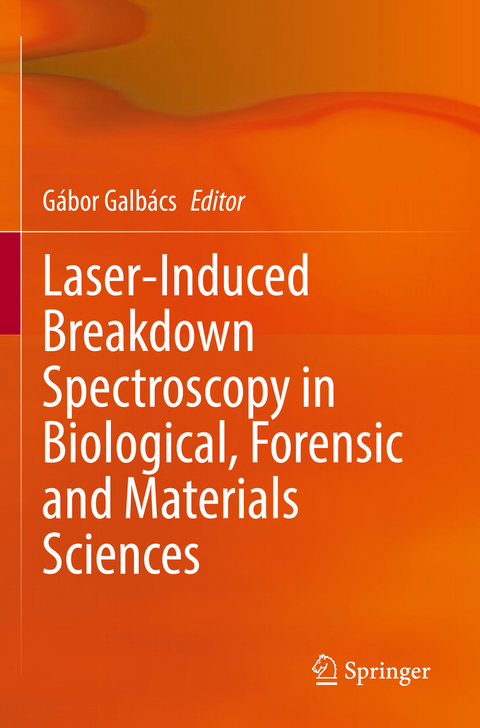
Laser-Induced Breakdown Spectroscopy in Biological, Forensic and Materials Sciences
Springer International Publishing (Verlag)
978-3-031-14504-9 (ISBN)
This book offers a comprehensive overview of recent advances in the area of laser-induced breakdown spectroscopy (LIBS), focusing on its application to biological, forensic and materials sciences. LIBS, which was previously mainly used by physicists, chemists and in the industry, has now become a very useful tool with great potential in these other fields as well. LIBS has a unique set of characteristics including minimal destructiveness, remote sensing capabilities, potential portability, extremely high information content, trace analytical sensitivity and high throughput. With its content divided into two main parts, this book provides not only an introduction to the analytical capabilities and methodology, but also an overview of the results of recent applications in the above fields. The application-oriented, multidisciplinary approach of this work is also reflected in the diversity of the expert contributors.
Given its breadth, this book will appeal to students, researchers and professionals interested in solving analytical/diagnostic/material characterization tasks with the application of LIBS.
Gábor Galbács is a full professor and the head of the Department of Inorganic and Analytical Chemistry at the University of Szeged, Hungary. He holds MSc diplomas in chemistry, physics and environmental sciences, as well as PhD, CSc and DSc degrees in analytical chemistry. He has over 30 years of experience in analytical spectroscopy research, focusing mainly on laser and plasma spectroscopy. Fundamental and applied research in laser induced breakdown spectroscopy has been one of his main research topics since 1999. Other fields where he also has a significant scientific activity includes inductively coupled plasma mass spectrometry (ICP-MS), inductively coupled plasma optical emission spectroscopy (ICP-OES), diode laser atomic spectroscopy, spark plasma spectroscopy, nanoparticle synthesis and characterisation by plasma techniques and development of sample introduction devices and methods. He has co-authored several international book chapters, review papers as well as university textbooks in the above fields. He has published nearly one hundred papers in international peer-reviewed scientific journals, authored over 250 conference papers, and supervised almost 100 theses. During his carrier, he spent over three years in Belgium and the USA as a visiting researcher and has active work connections with several research groups located all over Europe.
Part 1: Fundamentals.- Chapter 1: Laser-induced breakdown spectroscopy.- Chapter 2 : Quantitative analysis.- Chapter 3: Calibration-free quantitative analysis.- Chapter 4: State-of-the-art analytical performance.- Part 2: Applications.- Chapter 5: Preclinical evaluation of nanoparticle behavior in biological tissue.- Chapter 6: Imaging of biological tissues.- Chapter 7: Qualitative discrimination of biological materials.- Chapter 8: Nanoparticle-enhanced LIBS for biological applications.- Chapter 9: Analysis of forensic trace evidence.- Chapter 10: Advanced polymer characterization.- Chapter 11: Materials characterization by laser-induced plasma acoustics and spectroscopy.
| Erscheinungsdatum | 15.12.2023 |
|---|---|
| Zusatzinfo | VIII, 313 p. 1 illus. |
| Verlagsort | Cham |
| Sprache | englisch |
| Maße | 155 x 235 mm |
| Gewicht | 498 g |
| Themenwelt | Naturwissenschaften ► Chemie ► Analytische Chemie |
| Naturwissenschaften ► Chemie ► Physikalische Chemie | |
| Recht / Steuern ► Strafrecht ► Kriminologie | |
| Technik ► Maschinenbau | |
| Schlagworte | Analytical Spectroscopy • Biological Tissues • investigation of forensic evidences • laser-based diagnostic techniques • Laser Induced Breakdown Spectroscopy • material characterization techniques • Plasma Spectroscopy • quantitative and qualitative chemical analysis • sample identification and discrimination |
| ISBN-10 | 3-031-14504-6 / 3031145046 |
| ISBN-13 | 978-3-031-14504-9 / 9783031145049 |
| Zustand | Neuware |
| Informationen gemäß Produktsicherheitsverordnung (GPSR) | |
| Haben Sie eine Frage zum Produkt? |
aus dem Bereich


